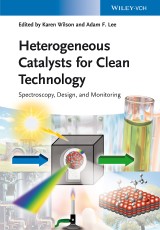Details
Heterogeneous Catalysts for Clean Technology
Spectroscopy, Design, and Monitoring1. Aufl.
|
160,99 € |
|
| Verlag: | Wiley-VCH |
| Format: | EPUB |
| Veröffentl.: | 17.09.2013 |
| ISBN/EAN: | 9783527659005 |
| Sprache: | englisch |
| Anzahl Seiten: | 504 |
DRM-geschütztes eBook, Sie benötigen z.B. Adobe Digital Editions und eine Adobe ID zum Lesen.
Beschreibungen
Reactive, but not a reactant. Heterogeneous catalysts play an unseen role in many of today's processes and products. With the increasing emphasis on sustainability in both products and processes, this handbook is the first to combine the hot topics of heterogeneous catalysis and clean technology.<br> <br> It focuses on the development of heterogeneous catalysts for use in clean chemical synthesis, dealing with how modern spectroscopic techniques can aid the design of catalysts for use in liquid phase reactions, their application in industrially important chemistries - including selective oxidation, hydrogenation, solid acid- and base-catalyzed processes - as well as the role of process intensification and use of renewable resources in improving the sustainability of chemical processes. <br> <br> With its emphasis on applications, this book is of high interest to those working in the industry.<br>
INTRODUCTION TO CLEAN TECHNOLOGY AND CATALYSIS<br> Green Chemistry and Clean Technology<br> Green Chemistry Metrics<br> Alternative Solvents<br> Heterogeneous or Homogeneous<br> Alternative Energy Reactors for Green Chemistry<br> Concluding Remarks<br> <br> MECHANISTIC STUDIES OF ALCOHOL SELECTIVE OXIDATION<br> Introduction<br> Metal-Catalyzed Alcohol Selox<br> Oxide, Sulfide, and Vanadate Catalysts<br> Solvent Selection<br> In Situ and Operando X-Ray Studies of Selox Catalysts<br> Conclusions<br> <br> REACTION MONITORING IN MULTIPHASE SYSTEMS: APPLICATION OF COUPLED IN SITU SPECTROSCOPIC TECHNIQUES IN ORGANIC SYNTHESIS<br> Introduction<br> Method Coupling<br> Spectroscopic Reactors and Practical Aspects<br> Selected Examples of Use<br> Conclusion and Outlook<br> <br> IN SITU STUDIES ON PHOTOCATALYTIC MATERIALS, SURFACE INTERMEDIATES, AND REACTION MECHANISM<br> Introduction<br> In Situ Investigations<br> Concluding Remarks<br> <br> ENANTIOSELECTIVE HETEROGENEOUS CATALYSIS<br> Introduction<br> Strategies for the Creation of Enantioselective Heterogeneous Catalysts<br> Concluding Remarks -<br> A Comparison of the Various Approaches to Heterogeneous Enantioselective Catalysts<br> <br> MECHANISTIC STUDIES OF SOLID ACIDS AND BASE-CATALYZED CLEAN TECHNOLOGIES<br> Introduction<br> New Catalytic Systems<br> Biomass Conversions<br> Summary<br> <br> SITE-ISOLATED HETEROGENEOUS CATALYSTS<br> Introduction<br> Assembled Monolayers of Metal Complexes on Single-Crystal Surfaces<br> Reaction-Induced and Photoinduced Formation of Unsaturated Ru Complexes Supported on SiO2 Surfaces<br> Manganese Triazacyclononane Catalysts Grafted under Reaction Conditions<br> Well-Defined Silica-Supported Mo-Imido Alkylidene Complexes for Metathesis<br> Double Catalytic Activation Using a Bifunctional Catalyst with both Acid and Base on Solid Surfaces<br> Summary<br> <br> DESIGNING POROUS INORGANIC ARCHITECTURES<br> Introduction<br> Templated Methods for the Preparation of Ordered Porous Materials<br> Hierarchical Porous Materials<br> Concluding Remarks<br> <br> TAILORED NANOPARTICLES FOR CLEAN TECHNOLOGY -<br> ACHIEVING SIZE AND SHAPE CONTROL<br> Introduction<br> Size Effects-Setting the Scene<br> Size Effects Illustrated by Way of Examples of Selected Industrially Important Reactions<br> Shape Effects<br> Conclusion<br> <br> APPLICATIO OF METAL-ORGANIC FRAMEWORKS IN FINE CHEMICAL SYNTHESIS<br> Metal-Organic Frameworks as Heterogeneous Catalysts<br> Applications in Carbon-Carbon Bond Formation<br> Applications in Oxidation, Carbon-Oxygen, and Carbon-Nitrogen Bond Formation<br> Applications in Asymmetric Synthesis<br> Concluding Remarks<br> <br> PROCESS INTENSIFICATION FOR CLEAN CATALYTIC TECHNOLOGY<br> Introduction<br> Effect of Transport Phenomena on Heterogeneous Catalysis<br> Conclusion<br> <br> RECENT TRENDS IN OPERANDO AND IN SITU CHARACTERIZATION: TECHNIQUES FOR RATIONAL DESIGN OF CATALYSTS<br> Introduction<br> Catalyst Nascence<br> Synthesis of Silicalite-1 Molecular Sieves<br> Preparation of Supported Metal Catalysts<br> Catalyst Life<br> Elucidating the Reaction Mechanism of Aerobic Oxidation of Benzyl Alcohol<br> Determination of the Active Sites in Aerobic Oxidation of Benzyl Alcohol<br> Catalyst Death<br> Methanol to Hydrocarbons<br> Propane Dehydrogenation<br> Summary and Conclusions<br> <br> APPLICATION OF NMR IN ONLINE MONITORING OF CATALYST PERFORMANCE<br> Online Monitoring with NMR Spectroscopy<br> Quantitative NMR Spectroscopy in Technical Samples<br> Flow and High-Pressure NR Spectroscopy for Reaction Monitoring<br> Selected Applications of NMR in Online Monitoring of Catalyst Performance<br> Conclusions<br> <br> AMBIENT-PRESSURE X-RAY PHOTOELECTRON SPECTROSCOPY<br> Introduction<br> Technical Aspects<br> Applications of APXPS<br> Outlook<br> <br>
<b>Dr Wilson</b> was educated at the Universities of Cambridge (PhD supervisor: Prof. Richard Lambert) and Liverpool. She moved to York in 1998, undertaking post-doctoral research on new mesoporous solid acids with Prof. James Clark, and was subsequently appointed to a lectureship at York in 1999. Karen was promoted to Senior Lecturer in 2007, prior to her appointment as Reader in Physical Chemistry at Cardiff University. Her research interests lie in the design of hierarchical porous solid catalysts for clean chemical synthesis, particularly the development of tuneable solid acids and bases for sustainable bio-diesel synthesis. She has recently been awarded a Royal Society Industry fellowship to work on new catalysts for biofuel production.<br /><br /><b>Prof Lee</b> carried out undergraduate and postgraduate studies at the University of Cambridge (PhD supervisor: Prof. Richard Lambert). He was appointed to a lectureship at the University of Hull in 1996, before moving to the University of York where he was promoted to Senior Lecturer (2006). In 2009, Adam was awarded an EPSRC Leadership Fellowship and appointed Professor of Physical Chemistry at Cardiff University. His research interests lie in the design of tailored nanocatalysts for green chemistry, and the development of in situ methodologies to provide mechanistic insight into surface processes.
Reactive, but not a reactant. Heterogeneous catalysts play an unseen role in many of today's processes and products. With the increasing emphasis on sustainability in both products and processes, this handbook is the first to combine the hot topics of heterogeneous catalysis and clean technology.<br> <br> It focuses on the development of heterogeneous catalysts for use in clean chemical synthesis, dealing with how modern spectroscopic techniques can aid the design of catalysts for use in liquid phase reactions, their application in industrially important chemistries - including selective oxidation, hydrogenation, solid acid- and base-catalyzed processes - as well as the role of process intensification and use of renewable resources in improving the sustainability of chemical processes. <br> <br> With its emphasis on applications, this book is of high interest to those working in the industry.<br>



















